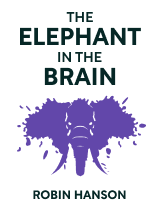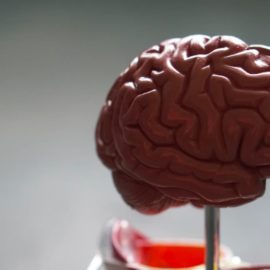

This article is an excerpt from the Shortform book guide to "The Elephant in the Brain" by Robin Hanson and Kevin Simler. Shortform has the world's best summaries and analyses of books you should be reading.
Like this article? Sign up for a free trial here .
Do doctors actually care about you? Why do people buy Teslas? What’s the hidden purpose of education?
In The Elephant in the Brain: Hidden Motives in Everyday Life, Kevin Simler and Robin Hanson argue that human behavior is driven by selfish motives hidden behind altruistic pretexts. They argue that, because we’re a cooperative social species, our brains evolved to hide our true motives not just from others, but from ourselves so as to balance our selfishness with our need to get along.
Keep reading for an overview of the book.
The Elephant in the Brain: Overview
Simler and Hanson call selfish motives “the elephant in the brain” because, like the metaphorical “elephant in the room,” they’re a large, unavoidable problem that nobody wants to acknowledge. And the elephant doesn’t affect us just as individuals—it shows up in institutions such as education, health care, and religion.
Therefore, Simler and Hanson say that, if we learn to recognize the elephant, we can improve ourselves by being less selfish or by turning our self-interest toward better ends. Moreover, without understanding the real motives driving our social systems, we stand little chance of reforming these systems to better achieve their intended goals.
Published in 2018, The Elephant in the Brain: Hidden Motives in Everyday Life emerged when Simler (a software engineer and blogger) approached Hanson (an economics professor) about forming an informal student-advisor relationship. The authors describe the resulting book as a doctoral thesis written for a general audience instead of a dissertation committee. Together, they draw on research from evolutionary biology, sociology, and psychology to advance their arguments. They acknowledge that their core idea—humans are selfish but pretend not to be—isn’t original, but argue that their application of this idea to large-scale social systems is. (Shortform note: In addition to his work in economics, Hanson is also known for his controversial social views.)
First, we talk about why we have hidden motives in the first place. Then we explore several areas in which these motives manifest—our communications; our use of money and other resources; and our social institutions such as health care, education, and religion. Finally, we discuss a few ways we can use our knowledge of hidden motives to improve our lives.
Part 1: Where Hidden Motives Come From
At first glance, the idea of hidden motives may seem convoluted—why hide our true intentions not just from others, but from ourselves? The answer, according to Simler and Hanson, is that as a cooperative social species, we evolved to advance our own interests while appearing as selfless as possible—and it’s easier to deceive others if we’ve already deceived ourselves. In this section, we’ll explore how human life is organized around a set of social games and how our hidden motives help us get ahead in these games.
We Excel at Social Games
Simler and Hanson believe hidden motives are an evolutionary adaptation. They argue that the human brain evolved to excel simultaneously at selfishness and cooperation. Because of the tension between selfishness and altruism, Simler and Hanson argue that the human brain evolved to play social games—competitions that require balancing self-interest with cooperation.
Social games typically revolve around three main goals: sex, social status, and politics. Simler and Hanson argue that social games require two main skills: the ability to attract good partners (mates, friends, allies) and to judge potential partners.
We Cheat at Social Games
Simler and Hanson emphasize that social games are competitive and not everyone can win. To maximize our chances, they say, we’ve evolved the skills needed not just to play these games, but also to cheat at them. To see how, we need to understand how norms regulate our social games and how we can get the upper hand by evading these norms.
Social Games Are Governed by Norms
Human cultures regulate selfish behavior and competition with norms—which are the rules and standards of a society. Sometimes they’re codified as laws and enforced centrally, but most often, norms are collectively enforced by the group as a whole. In short, norms teach us to regulate each other and to punish unwanted behavior with consequences ranging from eye rolls to gossiping to open violence. Perhaps more to the point, norms teach us to regulate ourselves.
Deception Lets Us Skirt Norms
Because norms evolved as a way to enforce pro-social behaviors like cooperation, sharing, and non-violence, our selfish motivations are at odds with the norms that govern us. But, rather than making humans less inherently selfish, Simler and Hanson say that norms led humans to evolve ways to advance our selfish motivations while appearing to adhere to social standards. In other words, we’ve developed a whole range of strategies for avoiding norm enforcement so that we can get away with “cheating” at our social games. These strategies include pretexts (socially acceptable reasons), discretion (avoiding openly stating our intentions), and toeing the line (testing the boundaries of norms).
Part 2: Hidden Motives in Daily Life
Hidden motives may have evolved when humans still lived in small foraging societies, but, according to Simler and Hanson, this phenomenon is now hard-wired into our brains. As a result, they say that hidden motives affect most aspects of our daily lives, from our interactions to our behaviors to our social institutions. In this section, we’ll explore how our communication is rife with hidden messages, how we use spending (and giving) to signal status, and how our social institutions are built around wholly different goals than the ones we admit to.
The Unspoken Messages in Our Conversation
Simler and Hanson argue that, while we might think the purpose of conversation is to share information, its actual purpose is for the speaker to advertise him/herself as a good potential ally. They say that good conversationalists exhibit two key qualities: they’re knowledgeable and they’re relevant.
Because conversation is really about signaling your social utility, Simler and Hanson say that another purpose of conversation is to build prestige. Simler and Hanson point out that listeners want to associate with prestigious speakers because that association raises the listener’s prestige as well.
The Unspoken Messages in Our Body Language
Simler and Hanson say that body language allows us to communicate about things that we’d never talk about openly. That’s because body language is unconscious, subtle, and deniable.
Simler and Hanson say that body language’s subtlety and deniability allow us to use it to communicate about things that norms would ordinarily tell us to avoid, such as sex and power.
Spending As Signaling
Simler and Hansen argue that many of our actions double as conspicuous fitness displays—they say to a potential mate, ally, or enemy: “Look how strong, wealthy, powerful, and connected I am.” This is especially noticeable when it comes to how we spend our money and other resources.
For example, the authors point to the well-known phenomenon of conspicuous consumption, where we buy expensive (and often superfluous or excessive) things to signal our wealth, status, and power to others. Simler and Hanson argue that this kind of signaling isn’t just about what you believe; it relies on your assumptions about what other people believe.
Likewise, Simler and Hanson argue that charity isn’t just about helping others—it’s also about showing off how compassionate and benevolent we are. Simler and Hanson also argue that giving is affected by visibility and peer pressure.
Social Institutions: Deceiving Ourselves Together
Just as our charitable giving hides selfish motives behind a conscious intent to help others, the authors say that many of our social systems are driven by motives other than the ones we recognize. That means that some of our most important institutions—including health care, education, and religion—are built around goals we’re not even aware of.
For instance, the authors argue that medicine isn’t just about healing—it’s also about showing conspicuous care. Simler and Hanson further argue that our professional health care systems function as a larger scale conspicuous care ritual which leads to medically inferior decisions.
The authors say that education isn’t just about learning—it’s also about molding students into good future employees and citizens. They argue that standardized schooling is a method for systematically overcoming humans’ natural resistance to authority. In other words, one function of school is to civilize students by getting them accustomed to power hierarchies, schedules, and being evaluated and judged. Above all, the authors suggest that the underlying motivation of schooling is to make people into good modern employees by teaching them to accept authority and routines. That’s why the authors argue that a main function of schools is to certify their graduates as good potential employees. From this, the authors conclude that employers care less about your education itself than they care about your degree—because of what the degree implies about you.
Similarly, the authors argue that religion isn’t just about belief, salvation, and higher purpose—it’s also about cementing and enforcing societal norms. They claim that deities typically stand in for society at large. So, sacrificing to a god shows that we’re willing to sacrifice for society. For this reason, they conclude that demonstrating religious belief indicates your willingness to pay your dues for the greater good of the social group. Meanwhile, other religious practices serve to distinguish adherents from non-adherents and implicitly signal things about the practitioner’s values. Visible components of religion—such as attire—serve to identify believers to each other and to outsiders.
Part 3: Final Thoughts on Taming the Elephant
If hidden motives really are as prevalent as Simler and Hanson say, we might be left with a bleak picture of humanity. But, there’s a silver lining to learning about the elephant: Once we recognize it, we can do something about it. Here are a few ideas about how taming the elephant lets us:
- Become less selfish and less self-deceived.
- Accept our selfishness and transform it into enlightened self-interest by deliberately helping others in order to advance ourselves.
- Design better institutions.
Exercise: Spot Your Own Elephants
Simler and Hanson argue that many of our actions are driven by selfish motives hidden behind altruistic facades. They say these motives—and our tendency to hide them—are built into the human brain, which means none of us are immune. With that in mind, see if you can identify some of your own elephants.
- Describe a time when you did or said something that you presented as selfless but was in fact selfish. Keep in mind that at the time, you may have genuinely thought your action was selfless.
- What was the real motivation behind your action? Why wouldn’t you have wanted to admit this motivation to others or yourself?
- If you face the same situation again, now armed with this awareness, do you think you will act differently? How so?

———End of Preview———
Like what you just read? Read the rest of the world's best book summary and analysis of Robin Hanson and Kevin Simler's "The Elephant in the Brain" at Shortform .
Here's what you'll find in our full The Elephant in the Brain summary :
- How human behavior is driven by selfish motives
- Why your own brain is hiding your intentions from you
- Why the purpose of education is to certify future employees






